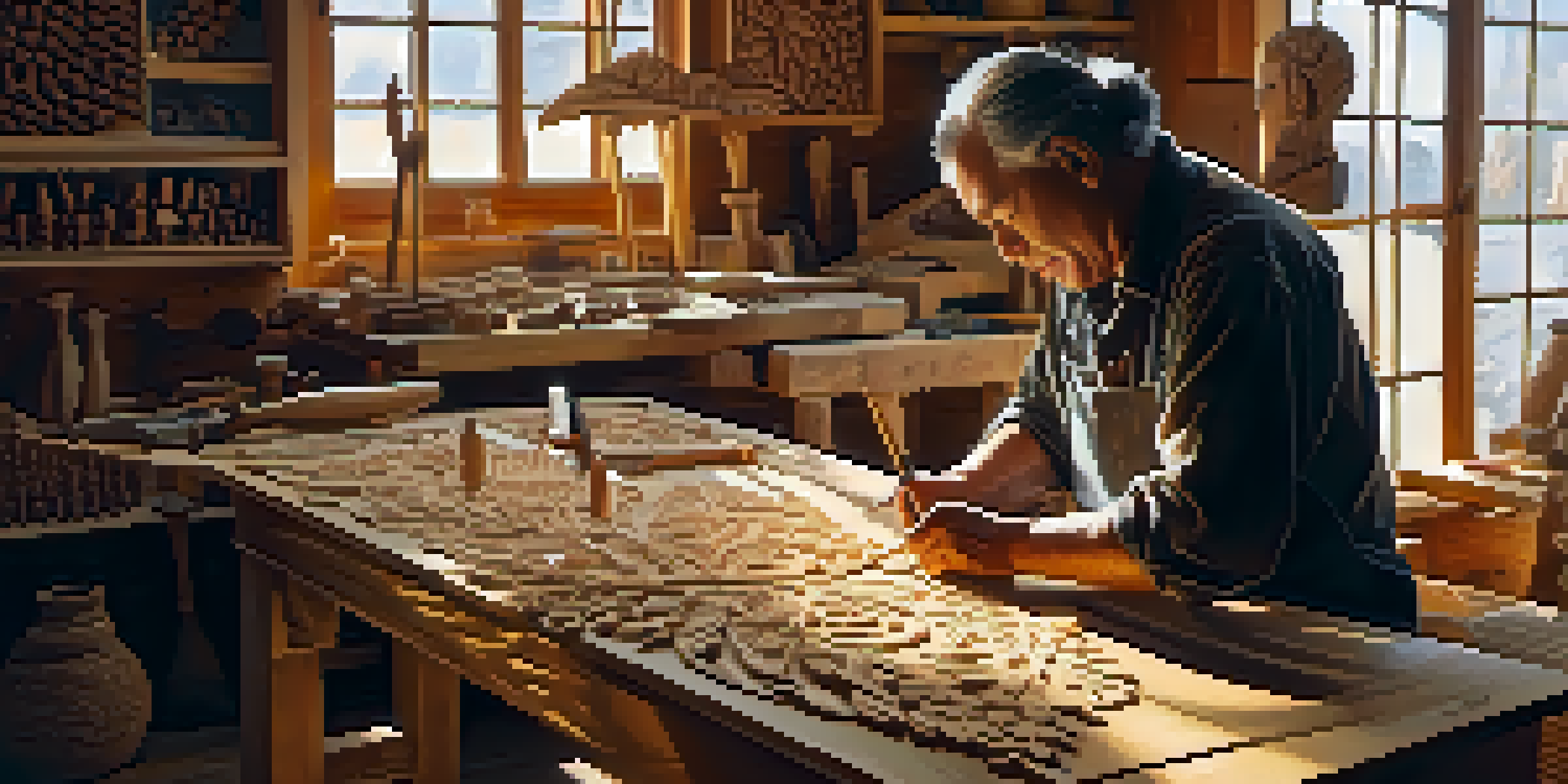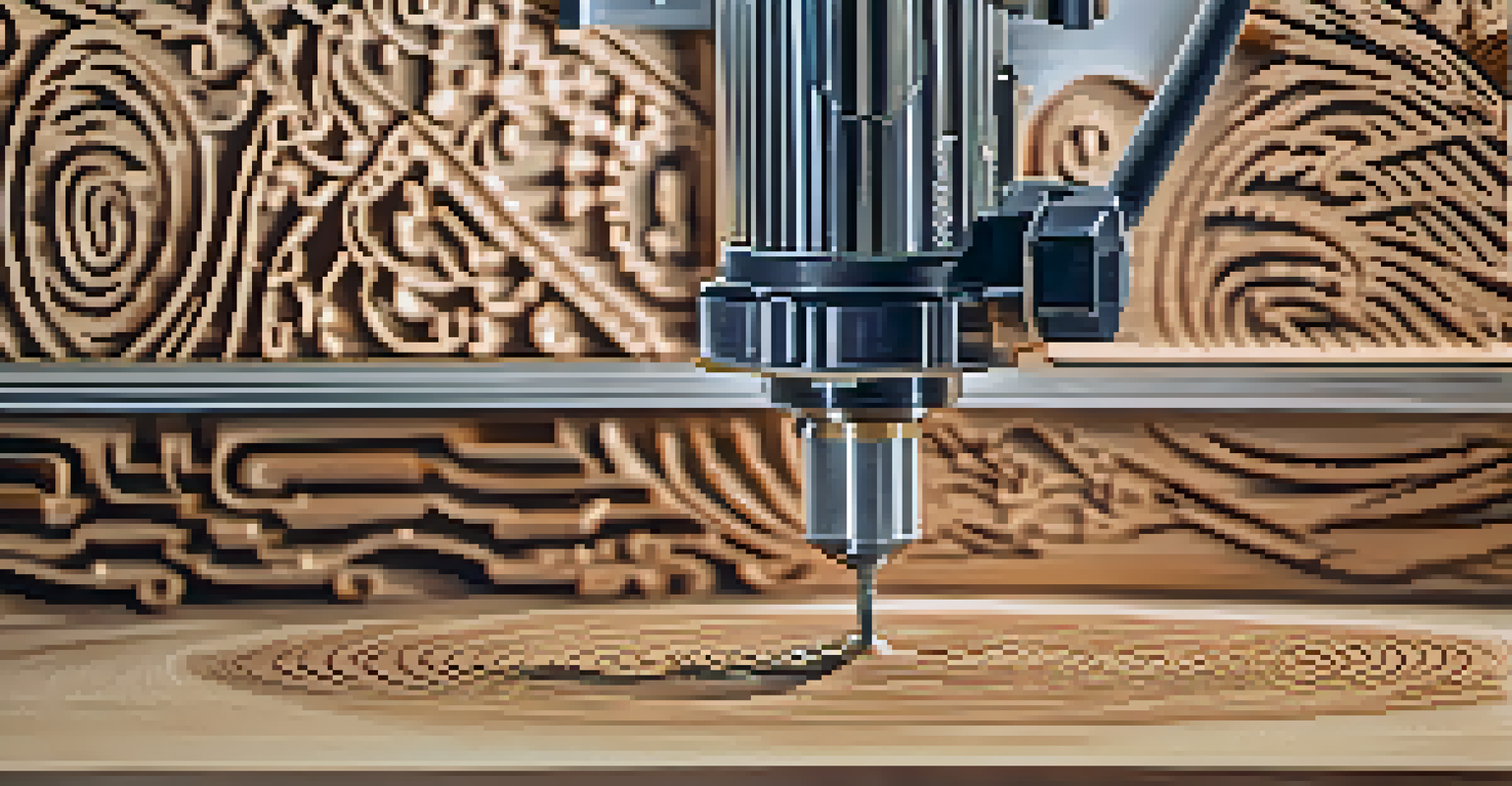The Impact of Digital Tools on Traditional Carving Skills

Understanding Traditional Carving Techniques and Their Value
Traditional carving is an age-old craft, steeped in history and culture. It involves shaping materials like wood or stone using hand tools, often passed down through generations. This craft not only showcases artistic talent but also embodies the cultural heritage of communities around the world.
Art is the most beautiful of all lies.
As we admire intricately carved sculptures and furniture, we recognize the skill and patience involved in this meticulous process. Each piece tells a story, reflecting the artisan's dedication and the techniques they’ve honed over time. The tactile experience of carving also connects artisans to their materials in a profound way.
However, with the rise of digital tools, the landscape of traditional carving is beginning to shift. While some purists argue that technology threatens the authenticity of this art form, others see it as a way to enhance creativity and efficiency in the carving process.
Digital Tools: A New Frontier for Carvers
Digital tools like CNC machines and 3D modeling software are revolutionizing how carving is approached. These technologies allow artists to design intricate patterns with precision, which can then be reproduced quickly and accurately. Imagine creating a complex design on a computer and watching it come to life through a machine's careful carving.

For many artisans, these tools serve as an extension of their creativity rather than a replacement for traditional methods. By combining digital design with hand-carving techniques, artists can experiment with new styles and ideas that may not have been feasible before. This blend of old and new opens up exciting possibilities.
Blending Tradition with Technology
Artisans are combining traditional carving techniques with digital tools to create innovative designs while preserving their craft.
Moreover, digital tools can also help preserve traditional techniques. By digitizing designs, artisans can create a library of patterns that can be shared, learned from, and built upon, ensuring that these skills continue to thrive in the modern age.
The Benefits of Integrating Digital Tools in Carving
One of the most significant advantages of digital tools in carving is efficiency. Tasks that once took hours or days can now be completed in a fraction of the time, allowing artisans to focus on the creative aspects of their work. This efficiency can lead to increased productivity and, ultimately, profitability for artists.
The most important thing about art is to work. Nothing else matters except sitting down every day and trying.
Additionally, digital tools can enhance the accuracy of carvings. For example, CNC machines can replicate designs with remarkable precision, reducing the margin for error that comes with hand-carving. This precision is particularly beneficial for large-scale projects or intricate designs that require consistency across multiple pieces.
Furthermore, the integration of digital tools can also attract a new generation of carvers. Younger artists, who are often more tech-savvy, may find digital design more appealing and accessible, ensuring that the craft continues to evolve and grow.
Challenges of Digital Tools in Traditional Carving
Despite the benefits, the integration of digital tools in traditional carving is not without its challenges. Some artisans may feel that using machines detracts from the authenticity and personal touch that hand-carving provides. This tension raises questions about what constitutes 'true' artistry in the carving world.
Moreover, the learning curve associated with digital tools can be steep. Not every traditional carver is comfortable with technology, and the fear of losing traditional skills can create resistance to change. For some, the comfort of familiar hand tools may outweigh the potential advantages that digital tools offer.
Challenges of Digital Integration
The shift to digital tools presents challenges, including concerns over authenticity, a steep learning curve, and accessibility issues for artisans.
Finally, there's the concern of accessibility. The cost of high-quality digital tools can be prohibitive for many artisans, especially those just starting. This can create a divide between those who can afford to embrace technology and those who cannot, potentially impacting the diversity of voices in the carving community.
Preserving Traditional Skills in a Digital Age
As digital tools become more prevalent, the challenge of preserving traditional carving skills grows. It’s essential for artisans to find a balance between embracing technology and maintaining the techniques that define their craft. Workshops and mentorship programs can play a pivotal role in teaching younger generations about traditional methods while integrating modern tools.
Communities can also foster this preservation by creating spaces for collaboration between traditional and digital artists. By encouraging dialogues, sharing techniques, and showcasing work that combines both approaches, the carving community can thrive amid technological advancements.
Ultimately, the goal is not to replace traditional carving skills but to enhance them. The digital age offers opportunities for innovation and growth, and by blending the old with the new, artisans can create a richer, more diverse carving landscape.
Real-World Examples of Digital and Traditional Carving Fusion
Around the world, numerous artisans are embracing the fusion of digital tools and traditional carving. For instance, some woodworkers use 3D modeling software to design intricate patterns, which they then hand-carve into their pieces. This method allows them to maintain the authenticity of their craft while exploring new creative avenues.
In another example, a group of stone carvers in Italy has started using digital tools to create templates for their sculptures. By doing so, they can ensure that their designs maintain a high level of accuracy while still allowing for the unique touches that come with hand carving.
Future of Carving Skills
Education and collaboration are essential for ensuring that traditional carving skills evolve harmoniously with digital advancements.
These examples illustrate that the marriage of digital technology and traditional carving does not diminish craftsmanship; rather, it elevates it. As artisans continue to explore this new frontier, the possibilities for innovation are endless.
Looking Ahead: The Future of Carving in a Digital World
As we look to the future, it's clear that digital tools will continue to influence traditional carving skills. The challenge will be for artisans to navigate this landscape while staying true to their craft. Embracing change while honoring tradition is a delicate balance, but one that many artists are willing to explore.
Education will play a crucial role in this evolution. By incorporating digital design into carving curricula, schools and workshops can prepare the next generation of artisans to work comfortably with both traditional and modern techniques. This holistic approach ensures that the essence of carving remains intact.

In conclusion, the impact of digital tools on traditional carving skills is profound and multifaceted. By weaving together the threads of innovation and tradition, the carving community can thrive in a digital age, celebrating the artistry that makes this craft so special.